Related Research Articles

Breton is a Southwestern Brittonic language of the Celtic language family spoken in Brittany, modern-day France. It is the only Celtic language still in use on the European mainland.

The Celtic Revival was a variety of movements and trends in the 19th and 20th centuries that saw a renewed interest in aspects of Celtic culture. Artists and writers drew on the traditions of Gaelic literature, Welsh-language literature, and so-called 'Celtic art'—what historians call Insular art. Although the revival was complex and multifaceted, occurring across many fields and in various countries in Northwest Europe, its best known incarnation is probably the Irish Literary Revival. Irish writers including William Butler Yeats, Lady Gregory, "AE" Russell, Edward Martyn, Alice Milligan. and Edward Plunkett stimulated a new appreciation of traditional Irish literature and Irish poetry in the late 19th and early 20th century.
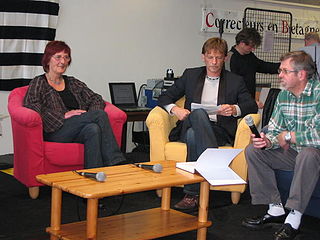
Breton literature may refer to literature in the Breton language (Brezhoneg) or the broader literary tradition of Brittany in the three other main languages of the area, namely, Latin, Gallo and French – all of which have had strong mutual linguistic and cultural influences.
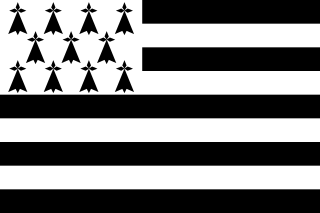
Breton nationalism is a form of regional nationalism associated with the region of Brittany in France. The political aspirations of Breton nationalists include the desire to obtain the right to self-rule, whether within France or independently of it, and to acquire more power in the European Union, United Nations and other international institutions.
Radio Rennes Bretagne was a radio station based in Rennes, and the first station to have regular Breton language programming. However, it was not powerful enough to broadcast to the Breton-speaking western parts of the peninsular. From November 1940 to June 1944 the station broadcast bilingual programming by switching over to Radio Paris for one hour each week.

Seiz Breur was an artistic movement founded in 1923 in Brittany. Although it adopted the symbolic name seiz breur, meaning seven brothers in the Breton language, this did not refer to the number of members, but to the title of a folk-story. At its height it had fifty members united as the "Unvaniezh Seiz Breur".
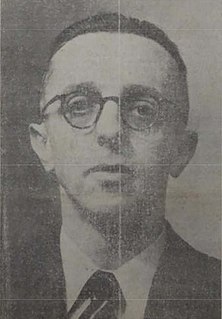
Olier Mordrel is the Breton language version of Olivier Mordrelle, a Breton nationalist and wartime collaborator with the Third Reich who founded the separatist Breton National Party. Before the war, he worked as an architect. His architectural work was influenced by Art Deco and the International style of Le Corbusier. He was also an essayist, short story writer, and translator. Mordrel wrote some of his works under the pen names Jean de La Bénelais, J. La B, Er Gédour, A. Calvez, Otto Mohr, Brython, and Olivier Launay.
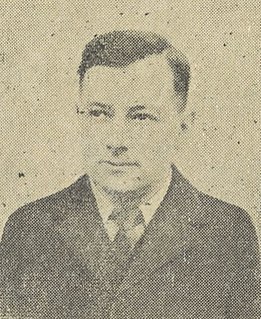
Louis-Paul Némo, better known by the pseudonym Roparz Hemon, was a Breton author and scholar of Breton expression. He was the author of numerous dictionaries, grammars, poems and short stories. He also founded Gwalarn, a literary journal in Breton where many young authors published their first writings during the 1920s and 1930s.

Morvan Marchal, is the Breton name of Maurice Marchal, an architect and a militant Breton nationalist. He is best known for having designed the national flag of Brittany.
René-Yves Creston, born René Pierre Joseph Creston, was a Breton artist, designer and ethnographer who founded the Breton nationalist art movement Seiz Breur. During World War II he was active in the French Resistance.

Xavier de Langlais was a Breton painter, printmaker and writer. He usually signed his work with the name Langleiz, a Breton language version of his surname.
Maurice Duhamel was the pen-name of Maurice Bourgeaux, a Breton musician, writer and activist who was a leading figure in Breton nationalism and federalist politics in the years before World War II.
Gwilherm Berthou was a Breton nationalist and neo-Druidic bardic poet. He was a member of the Breton artistic movement Seiz Breur.
Youenn Drezen is the Breton language name of Yves Le Drézen, a Breton nationalist writer and activist. He is also known as Corentin Cariou and Tin Gariou.
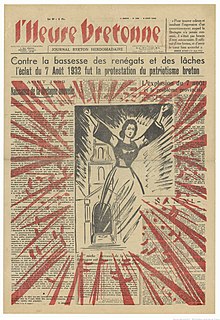
L'Heure Bretonne was a Breton nationalist weekly newspaper which was published from June 1940 to June 1944. It was the organ of the Breton National Party and was strongly associated with collaborationist politics during World War II.

François Eliès, born Fañch Eliès and better known by the pseudonym Abeozen, was a Breton nationalist, novelist and dramatist who wrote in the Breton language. Abeozen was also a noted scholar of the Welsh language.
The Regional literature of France, besides literature written in the French language, may include literature written in other languages of France. In the medieval period many of the competing standard languages in various territories that later came to make up the territory of modern France each produced literary traditions, such as Anglo-Norman literature and Provençal literature.

Ronan Huon, also called René Huon,, was a Breton language writer and editor. He was director and chief editor of the magazine Al Liamm for over fifty years. His work has been recognized for its contribution to the Breton language and its literature.
Al Liamm is a bimonthly magazine of culture and literature in the Breton language.
References
- ↑ Alain Deniel, Le mouvement breton, Maspéro, 1976, ISBN 2-7071-0826-X, p. 69